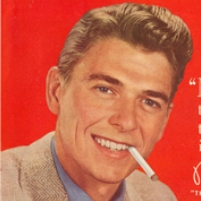Drop in Cigarette Use Mirrors Drop in Smoking in Movies
Saturday, April 24, 2010

Life has mirrored art when it comes to declines in cigarette smoking, according to a research study of Hollywood films since 1950. Patrick Jamieson and Dan Romer examined a sampling of the top 30 grossing U.S. movies each year from 1950 to 2006, 855 films in all, looking for tobacco-related content and main characters who smoked, and found fewer films over time that included this behavior.
The study examined not just actual smoking, but also “tobacco-related cues,” such as brand logos, smoke-filled rooms and ashtrays with lit cigarettes.
“Total tobacco-related content peaked around 1961, while the decline in portrayal of main character use was already underway in 1950,” reads the report. “Cigarette consumption peaked around 1966 with a trend that closely paralleled total tobacco content and that coincided with major tobacco control events,” including the 1964 U.S. Surgeon General’s report on the dangers of smoking and the banning of cigarette ads on television in 1971.
In 2007, the Motion Picture Association of America (MPAA) announced that it would take portrayals of smoking outside of an historical context into account when creating ratings. However, a 2009 report, Two years later: Are MPAA’s tobacco labels protecting movie audiences?, discovered that not a single film had had its rating changed because of tobacco-related content.
-David Wallechinsky, Noel Brinkerhoff
Trends in U.S. Movie Tobacco Portrayal since 1950: An Historical Analysis (by Patrick E. Jamieson and Dan Romer, Annenberg Public Policy Center) (pdf)
- Top Stories
- Unusual News
- Where is the Money Going?
- Controversies
- U.S. and the World
- Appointments and Resignations
- Latest News
- Bashar al-Assad—The Fall of a Rabid AntiSemite
- Trump Announces He Will Switch Support from Russia to Ukraine
- Americans are Unhappy with the Direction of the Country…What’s New?
- Can Biden Murder Trump and Get Away With it?
- Electoral Advice for the Democratic and Republican Parties






Comments